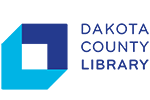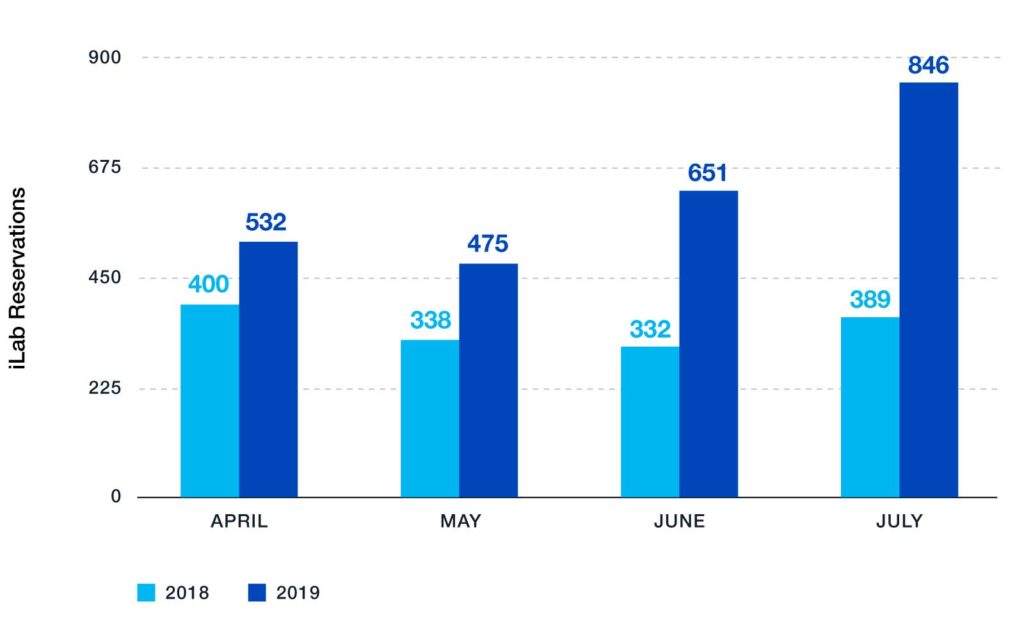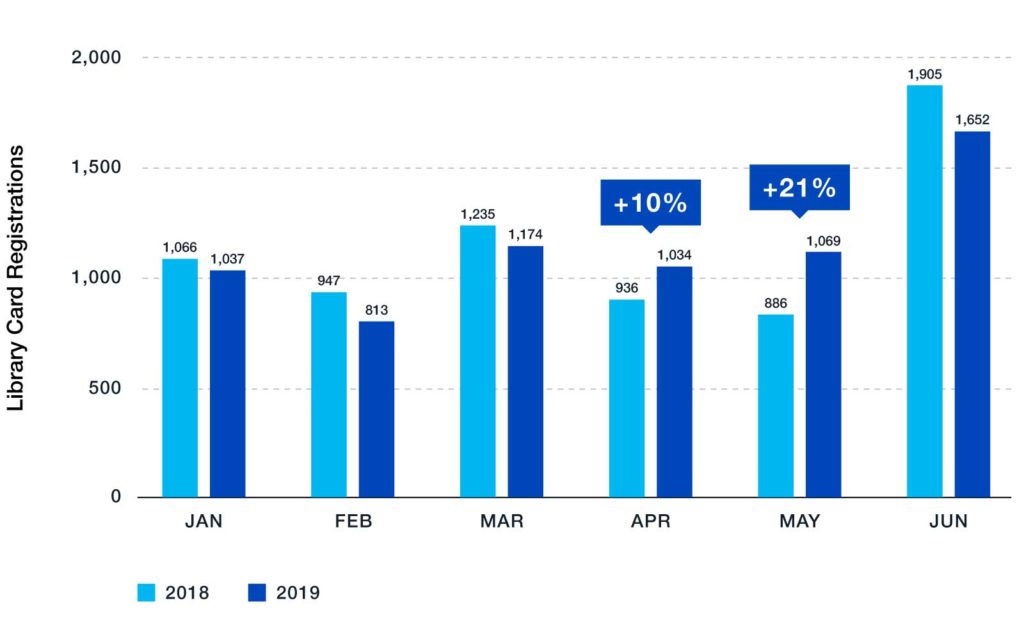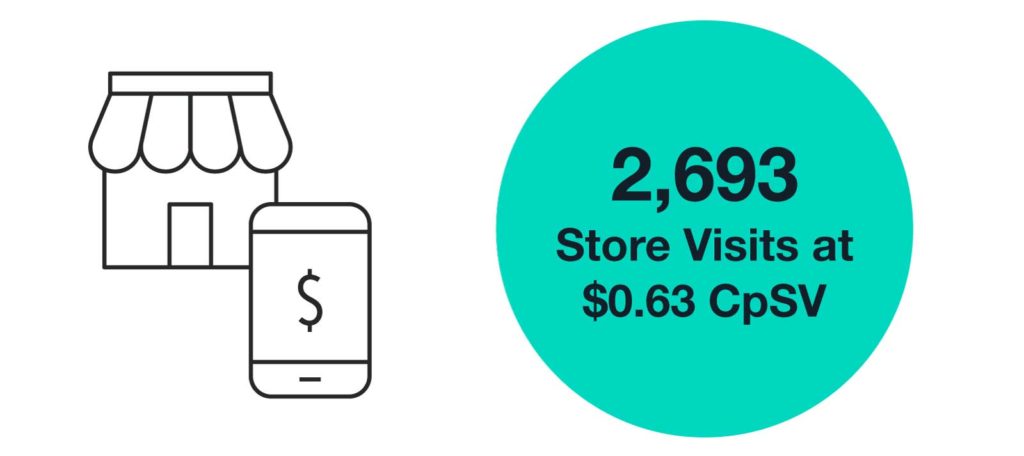

Success Story: Dakota County Library
Exploring the Possibilities with Digital Advertising

Client Overview
Dakota County Library has reinvented itself as a resource center for cultivating community, creativity, and learning through exploration
The Library’s primary interest is in promoting awareness and usage of their iLab, convenient spaces for innovation, learning, exploration and creativity. Secondary goals include driving library card signups and additional foot traffic to library locations.
For this project, we created a mix of search, YouTube, and GDN campaigns in Google Ads, as well as Image and Instant Experience ads in Facebook for the client’s first major introduction to digital advertising.

Services:
- Paid Media
- Strategic Consulting
Client Segments:
- Education
- Non Profit
Project Goal
Increase reservations, signups, and overall foot traffic

Opportunities
General Measurability: Digital marketing provides an unparalleled amount of measurability, telling us how our media is performing in a much deeper way than traditional media is capable of.
Measuring Public Reaction: Facebook and Instagram allows us to measure not only how people are interacting with our content, but how they’re reacting to it and engaging with it as well.
Google-Hosted Conversions: Google-hosted conversions, including clicks to get directions and store visits allow us to see how often our ads inspired users to take the most impactful actions.
Wide Variety of Audience Data: Audience data available across Google and Facebook allows us to make targeting more granular, but also gives the client a wealth of insight into who their audience is made up of, and what their interests are.
Challenges
Lack of Brand Independence: Dakota County Library holds a subsidiary status to Dakota County itself. The client was prevented from having their own analytics account, their own YouTube account, or their own website URL, resulting in our team needing to “work around” limitations that wouldn’t otherwise exist.
Landing Page Restrictions: Having to share the county domain URL meant working with two uneditable panes in the top and left side of every page which were organized confusingly, often irrelevant, and provided ample opportunity for users to disengage, or fall away from the intended path.
Tracking Restrictions: Every page on which users were capable of performing our most valuable actions (iLab rentals and reservations) was hosted on a different website which we were not able to get analytics on. This resulted in our primary online goals being relegated to loads of the page where users could find the link to the other site.
Untrustworthy Self-Reported Offline Data: While the Library had access to internal data to help qualify the performance metrics we were seeing, it was rife with unreliable self-reported data that inflated certain iLab usage metrics, adding difficulty to making accurate M/M and Y/Y comparisons.
Legal Requirements: Legal requirements barred us and the Library from using certain phrasing in advertisements that would have allowed for a clearer, easier to understand value proposition (the word “free” being the primary example).
Our Approach
Track Everything: This being the client’s first experience with a full-fledged digital marketing campaign, we ensured tracking was in place for every action we deemed important for the purpose of future analysis.
Observe Everything: We ensured we were observing a wide mix of audiences for the purposes of making optimizations later, and also informing the client of who made up their audience.
Start Big and Go Granular: We used half of the budget for our 6-month campaign in the first 2 months to capture enough data to inform optimization decisions for the duration of the campaign. Through this, we were also able to learn that our targeting (limited to Dakota County exclusively) would not result in limited volume.
Layered Location Targeting: We applied 2-mi radii targeting around each library location, layered on top of our Dakota County targeting, to determine which individual libraries were seeing the greatest benefits from our campaign, and to help ensure that a single location wasn’t prioritized above others.
Testing Key Components: Respective of the effort that went into developing approved phrasing for both display and text ads, we ensured our campaigns were set up as tests, to provide the client with measurable results of their efforts.
Prioritize Location Extensions: Knowing that so many of our campaign goals relied on either fuzzy, or entirely offline KPIs, we made sure the client was set up on Google My Business, that it was connected to Google Ads, and that all our eligible campaigns had location extensions assigned, in order to record the maximum amount of Google-hosted conversions and location-specific data possible. This allowed us to relate our online advertising to offline goals to the greatest extent possible.
Results & Insights
During our campaign, a record number of iLab reservations was set twice resulting in a 70% increase.

We saw a 10% and 21% increase in library card registrations in April and May.

In July, there were 2,693 visits to a Library location.

What did we learn?
Optimizing online activity towards offline goals is difficult. Using as many tools as possible (including Google My Business and Location Extensions) to bridge the gap is not only helpful, but an absolute necessity.
Establishing performance expectations prior to campaign start makes it easier to communicate performance milestones when significant numbers are hit.
Tell us about your next project
Whether you have questions about how we can help your business or want to explore the possibility of working together, please contact us.
